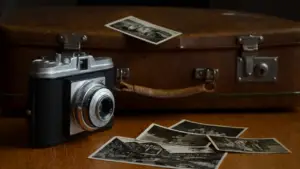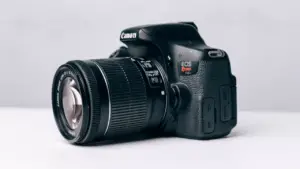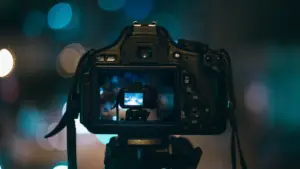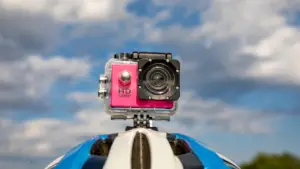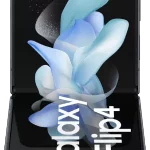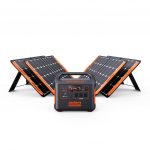Disposable cameras, also known as single-use cameras, are ready-to-use, inexpensive film cameras intended for one-time use. They come pre-loaded with a roll of film and typically have a built-in flash mechanism. Once all the photos are taken, usually between 24 and 36 exposures depending on the model, the entire camera is returned to a photo lab for film processing.
These cameras are designed for simplicity and convenience. They do not require the user to load film or worry about settings such as shutter speed, aperture, or focus, making them an accessible choice for beginners or casual photographers. The viewfinder is typically a simple, direct optical viewfinder.
Disposable cameras are popular at events, such as weddings or parties, where they may be distributed to guests to capture candid moments. They are also often used by travelers, hikers, and festival-goers who want to take photos without risking damage to an expensive camera.
Although the rise of digital photography has significantly reduced the demand for disposable cameras, they continue to hold a niche appeal due to their unique aesthetic, simplicity, and the tangible element of film photography.
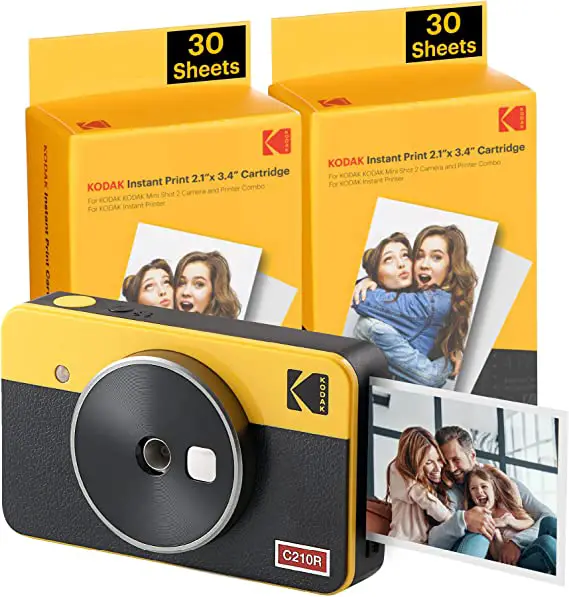
Table of Contents
Components of disposable cameras
Camera body
The body of a disposable camera is usually made from lightweight, inexpensive plastic to keep the overall cost of the camera low. Despite its minimal cost, the plastic body provides enough protection to protect the film and internal components from damage during regular use. It typically includes a simple viewfinder for framing shots, a shutter button for taking pictures, a wheel or lever for advancing the film, and sometimes a switch or button to activate the flash.
Lens
The lens is crucial to any camera as it focuses light onto the film to create images. In disposable cameras, the lens is generally fixed-focus and made of plastic. It is designed to provide acceptable sharpness and clarity for common snapshot distances. The aperture, or the opening that controls the amount of light reaching the film, is also fixed and chosen to be a good compromise for typical lighting conditions. These lenses usually have a focal length wider than normal, around 30mm to 35mm, suitable for various everyday photography scenarios.
Film
Disposable cameras come pre-loaded with a roll of film. The type of film can vary by brand and model, but it is typically color-negative film with an ISO speed rating of 400 or 800, making it versatile in various lighting conditions. The film is sensitive to light, and when an image is taken, the film records that image. The number of potential pictures, or exposures, depends on the camera model, but it usually ranges from 24 to 36.
Flash system
Most disposable cameras have a built-in flash system to allow photography in low-light conditions; This is often a small electronic flash powered by a tiny battery inside the camera body. The flash, when activated, emits a brief burst of bright light at the same moment the shutter opens, illuminating the scene to ensure sufficient exposure. Some disposable cameras have a switch or button to manually activate the flash, while others might have an automatic sensor to determine when the flash is necessary.
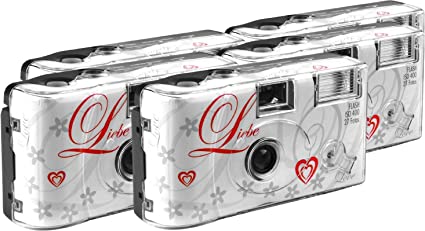
How disposable cameras work
Film exposure process
Film exposure in a disposable camera begins when the shutter button is pressed. The light from the scene enters through the camera’s fixed-focus lens and strikes the light-sensitive film. This light causes a chemical reaction in the film’s emulsion, altering it in a way that records an image.
The film used in disposable cameras is typically color-negative film. When developed, it produces a negative, where the colors and brightness values are the opposite of those in the original scene. This negative can then be used to create positive prints.
After taking a picture, the user manually advances the film using a wheel or lever, positioning a fresh, unexposed film section behind the lens for the next shot.
Shutter mechanism
The shutter mechanism in a disposable camera is straightforward and primarily consists of two components: the shutter button and the shutter itself. When the shutter button is pressed, the shutter, which usually sits in front of the film, briefly opens to allow light to reach the film.
Disposable cameras typically have a simple leaf or spring-based shutter that opens for a fixed duration when the shutter button is pressed, providing adequate exposure for a wide range of lighting conditions. The exposure time cannot be manually adjusted as it can be in more advanced cameras.
Flash activation
The flash in a disposable camera illuminates scenes too dark for proper exposure. When the flash is required, it’s triggered simultaneously with the opening of the shutter to ensure the film captures the light it produces.
The flash system consists of a small electronic flash unit powered by a miniaturized battery. Some disposable cameras automatically activate the flash in low light, while others require the user to press a switch or button to activate it manually. After the flash is used, it needs a few seconds to recharge before it can be used again. This charging period is why there’s a slight delay between flash photographs taken with a disposable camera.
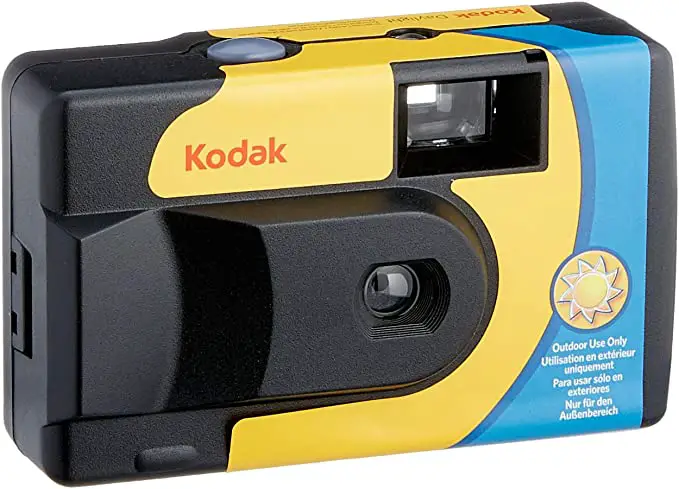
Popular brands of disposable cameras
Kodak
Kodak is a well-recognized name in the photography industry and has been producing disposable cameras for several decades. Their offerings have remained popular due to the company’s legacy and consistent quality. One of their iconic models is the Kodak FunSaver, a single-use camera pre-loaded with Kodak 800 ISO film. It is equipped with a manual flash, has 27 exposures, and is known for delivering warm and vibrant colors.
Fujifilm
Fujifilm is another industry giant that has offered a range of disposable cameras. Their QuickSnap series is highly popular and has various outdoor and waterproof versions. The Fujifilm QuickSnap Flash 400 camera, pre-loaded with Superia X-TRA 400 film, provides a quality option for general use. Fujifilm disposable cameras are known for their excellent color reproduction and sharpness.
Telford
Ilford specializes in black-and-white photography and offers disposable cameras pre-loaded with their black-and-white films. Models like the Ilford HP5 Plus and XP2 Super single-use cameras provide photographers with an easy way to experience the depth and richness of black-and-white film photography. These cameras come with a built-in flash and offer 27 exposures. Images produced by Ilford’s disposable cameras are noted for their distinct tonal range and impressive contrast.
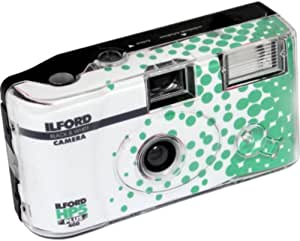
Best disposable cameras
Kodak SUC daylight 39 800ISO
The Kodak Single Use Camera (SUC) Daylight 39 800ISO is a popular disposable camera model from Kodak.
The camera comes pre-loaded with Kodak’s 800 ISO film, a versatile, high-speed film suitable for various lighting conditions. The 800 ISO rating makes it a good choice for both outdoor and indoor use in bright daylight, and it can capture reasonably clear images even in lower-light situations.
The number’ 39′ refers to the camera’s number of exposures. In this case, the camera allows for 39 shots, slightly more than most disposable cameras that typically offer between 24 and 36 exposures.
This camera model does not have a built-in flash, hence the term ‘Daylight’ in its name; This means it performs best in well-lit situations, primarily outdoors during the day. However, the high ISO film allows it to perform reasonably well in dimmer conditions compared to other daylight-only disposable cameras.
Kodak’s disposable cameras are well-regarded for their color reproduction, delivering images with Kodak’s iconic warm and vibrant colors. Like all disposable cameras, the Kodak SUC Daylight 39 800ISO offers a simple point-and-shoot experience, making it a great choice for parties, vacations, or any occasion where you want a straightforward, hassle-free camera.
Ilford HP5+ single-use disposable camera
The Ilford HP5 Plus Single Use Camera is a disposable camera pre-loaded with Ilford’s HP5 Plus film; This is a black-and-white film with a speed of ISO 400, making it versatile for various lighting conditions.
Ilford is renowned for its high-quality black and white films, and the HP5 Plus film is one of its most popular offerings. This film is known for its fine grain and wide exposure latitude. It can handle various lighting situations and still produce well-exposed images.
The HP5 Plus Single Use Camera includes a built-in flash that can be manually activated, making it possible to use this camera indoors or in lower light conditions, which is not typically ideal for other disposable cameras.
This camera offers 27 exposures, which is standard for most disposable cameras. It’s a great choice for those who want to experiment with black-and-white photography without investing in a full-fledged film camera. The Ilford HP5 Plus Single Use Camera delivers high contrast, richly detailed images characteristic of traditional black and white photography, making it a popular choice for beginners and more experienced photographers.
Fujifilm Quicksnap 400 disposable flash camera
The Fujifilm QuickSnap Flash 400 is a popular disposable camera model from Fujifilm.
This camera comes pre-loaded with Fujifilm’s ISO 400 color film, a versatile film that works well in various lighting conditions. The ISO 400 film is a good middle-ground film speed, ideal for bright outdoor and dimmer indoor settings.
One of the standout features of the QuickSnap Flash 400 is its built-in flash, which can be used for up to 10 feet. The flash is manually activated, making this camera suitable for low-light situations other disposable cameras may struggle with; This is particularly useful for indoor settings, evening events, or nighttime photography.
The Fujifilm QuickSnap Flash 400 provides 27 exposures, a common number for disposable cameras. Its simple point-and-shoot operation is easy to use, making it a great choice for events, parties, casual photography, or situations where you might not want to bring an expensive camera.
In terms of image quality, Fujifilm’s film is known for its excellent color reproduction, providing images with vibrant, true-to-life colors. The QuickSnap Flash 400 is a versatile, user-friendly disposable camera that delivers high-quality images considering its disposable nature.
TopShot love white disposable wedding camera
The TopShot Love White Disposable Wedding Camera is a special single-use camera designed with weddings and celebrations in mind.
The camera body typically features a festive, wedding-themed design, often in white to match traditional wedding color schemes. Some models include decorative elements such as hearts, rings, or other romantic symbols.
This camera comes pre-loaded with color film, usually with an ISO rating of 400, making it versatile enough for indoor and outdoor use. The number of exposures can vary, but it usually offers around 27 shots, which is standard for disposable cameras.
One crucial feature of a wedding disposable camera is the built-in flash; This allows it to capture photos in various lighting situations, such as a dimly lit reception or evening party. The flash range typically covers up to 10 feet, ensuring that subjects close to the camera are well-lit.
The TopShot Love White Disposable Wedding Camera offers a simple point-and-shoot operation, making it easy for wedding guests of all ages to use. It’s a popular choice for wedding receptions, as multiple cameras can be placed on tables, and guests can capture candid shots throughout the celebration; This allows the couple to have a collection of spontaneous, personal photos from their guests’ perspectives to supplement the formal photographs from a professional photographer.
Remember, though, that image quality from a disposable camera won’t match that of a professional camera. Nonetheless, the photos can have a unique, nostalgic charm that can be a delightful addition to a wedding photo album.
Kodak mini shot 2 Retro portable instant camera
The Kodak Mini Shot 2 Retro Portable Instant Camera is a modern take on instant photography that combines the immediate gratification of instant film with digital convenience.
Design and features: The Mini Shot 2 Retro maintains a compact and lightweight design that’s easy to carry around, with a retro aesthetic reminiscent of classic Kodak cameras. The body usually comes in various colors, allowing users to choose one that suits their style.
Camera functionality: Unlike a disposable camera, the Mini Shot 2 Retro is a digital camera that lets you preview and edit your photos before printing them. This instant camera includes features like auto-focus, exposure adjustment, and white balance control, typically absent in disposable cameras. These features provide more flexibility and control over your photos, helping you achieve the desired results before printing.
Printing capability: The standout feature of the Mini Shot 2 Retro is its built-in instant printer. Using 4Pass printing technology, it prints 2.1 x 3.4-inch photos directly from the camera onto Kodak cartridge paper. The prints are high-quality, vibrant, and long-lasting, with a laminated layer that makes them waterproof and fingerprint-proof.
Connectivity: Besides functioning as a standalone camera and printer, the Mini Shot 2 Retro can connect to your smartphone via Bluetooth; This allows you to print photos directly from your phone or even use your phone as a remote shutter for the camera. The Kodak Mini Shot app offers a range of editing tools, letting you enhance your photos with filters, stickers, and more.
Power: The camera has a rechargeable battery, typically charged using a micro USB cable; This means you can use it repeatedly, unlike single-use disposable cameras.
Applications of disposable cameras
Weddings and events
Disposable cameras are popular at weddings, parties, and other events. Placing one at each table or distributing them among guests encourages people to capture candid moments throughout the celebration. These cameras are particularly useful in capturing a different perspective, as guests often use them rather than professional photographers. The film’s unique aesthetic can also provide a nostalgic touch to these pictures.
Travel and adventure
Disposable cameras are ideal for travel and outdoor adventures due to their compact size, lightweight nature, and simple use. They are robust and less risky to carry around than expensive digital equipment, especially when traveling in harsh environments, crowded places, or areas prone to theft. Some brands even offer waterproof disposable cameras, perfect for snorkeling or beach vacations. The element of surprise that comes with developing the film after the trip adds a unique aspect of excitement to the travel experience.
Educational use
Disposable cameras can be valuable in education, particularly in teaching photography basics. They provide an affordable and accessible introduction to film photography, making them an excellent choice for school projects or photography workshops. Given the limited number of exposures available, students can learn about film exposure, composition, and the importance of each shot.
Art and creative photography
Some artists and photographers prefer disposable cameras for their unique aesthetic qualities, which can be difficult to replicate with digital equipment. The characteristics of film, the unpredictability, and sometimes even the technical limitations of disposable cameras can be creatively exploited to achieve desired effects. The resulting images often have a distinct, retro look and feel that can add depth and atmosphere to artistic works.
Advantages of disposable cameras
Cost and convenience
Disposable cameras are considerably less expensive than most film or digital cameras, making them a cost-effective choice for casual or occasional photography. This affordability also makes them a viable option for situations with a risk of loss or damage, such as at large events or during travel. Additionally, they come pre-loaded with film and usually have a built-in flash, eliminating the need to purchase these items separately. Once the film is used, the entire camera can be dropped off for development, providing a convenient, all-in-one photography solution.
Uniqueness of outcome
One of the key attractions of disposable cameras is the unique aesthetic of the photos they produce. Images captured on film have a distinct look and feel, often described as warm and organic, that is different from digital photos. The imperfections, such as grain, light leaks, or slight blurriness, add to the charm and character of the photos. Furthermore, the anticipation of waiting to see how the photos turn out after they are developed adds an element of surprise and excitement.
Simplicity and ease of use
Disposable cameras are incredibly simple to use, with minimal controls and settings to adjust; This makes them ideal for beginners, children, or anyone who wants to take pictures without the complexity of a regular camera. You don’t need to know about shutter speeds, aperture settings, or ISO levels – you just point, shoot, and let the camera do the work. This simplicity allows users to focus more on their subjects and composition than on technical details.
Disadvantages of disposable cameras
Image quality
While the image quality from disposable cameras can be charming and aesthetically pleasing in its own right, it cannot compete with that of higher-end film or digital cameras. Images may lack sharpness, and the fixed aperture and shutter speed can limit the camera’s ability to handle various lighting conditions. Colors can be less vibrant, and contrast might be lower than in images produced by more advanced cameras. Also, because the viewfinder is not through the lens, what you see might not perfectly match what the lens captures, leading to framing inaccuracies.
A limited number of shots
Disposable cameras come with a fixed number of exposures, typically between 24 and 36, which limits the number of pictures you can take. Once all the shots are used, you cannot reload the camera with new film; instead, you have to purchase a new disposable camera; This can be limiting for longer trips or events where many photos are desired.
Environmental impact
The single-use nature of disposable cameras can lead to significant waste, as the entire camera body is discarded after use. While some parts of the camera can be recycled, not all recycling programs accept disposable cameras, and many cameras end up in landfills. Additionally, the chemicals used in film development can have a negative environmental impact if not disposed of properly. Some manufacturers have created recycling programs for disposable cameras, but this is not a universal practice. As such, disposable cameras are not the most environmentally friendly option for photography.
The process of developing film from disposable cameras
Traditional darkroom process
Developing film from disposable cameras traditionally involves several steps in a darkroom. First, the film is removed from the camera body in a light-tight bag or room to prevent exposure to light, which could ruin the film. Then, the film is placed into a developing tank.
Next, various chemicals are used in a specific sequence to develop the film. The first is the developer, which reacts with the exposed areas of the film to form a latent image. The film is then rinsed and placed in a stop bath, which halts the development process. Following the stop bath is a fixer, which makes the image permanent and insensitive to further exposure. The film is rinsed again to remove any remaining chemicals.
Once the film is developed, it’s dried and printed onto photo paper using an enlarger. This process also takes place in a dark room. The prints are developed using a similar chemical process, then washed and dried.
Modern techniques
In many modern photo labs, film processing has been largely automated. Disposable cameras can often be dropped off at a photo lab, where machines remove, develop, and print the film onto photo paper. This process reduces the chances of human error and increases development speed.
Most modern photo labs can also digitize the developed negatives, creating digital files that can be transferred onto a CD or USB drive or sent via email. This option allows for easy sharing, storing, and editing of photos on a computer.
DIY options
Developing film at home is also an option for those interested in the hands-on process; This requires purchasing the necessary chemicals and equipment and learning the development process, which can be intricate and time-consuming but also rewarding. There are many tutorials and guides available online to help beginners get started with home film development.
For disposable cameras, the first challenge is to safely extract the film from the camera body without exposing it to light; This is typically done in a completely dark room or using a special light-tight bag. The rest of the development process resembles the traditional darkroom method described above. After the film is developed, it can be scanned using a film scanner to create digital copies of the photos.
Disposable cameras in the digital age
Nostalgic appeal and aesthetic
In the era of high-definition digital photography, disposable cameras offer a stark contrast with their distinct, film-based aesthetic. The images they produce often have a sense of warmth, character, and nostalgia that can appeal to many. This unique aesthetic is hard to reproduce digitally, making disposable cameras a tool of choice for certain creative or retro-inspired projects.
Additionally, disposable cameras bring back the element of anticipation and surprise inherent in film photography. In the digital age, where images can be instantly viewed and endlessly retaken, the wait to develop film and discover how the photos turned out introduces excitement and unpredictability.
Revival and recent trends
While disposable cameras had a dip in popularity with the advent of digital cameras and smartphones, they have seen a recent revival, particularly among younger generations. This resurgence is part of a broader trend of analog technologies reclaiming a place in a digital world, much like vinyl records in the music industry.
Disposable cameras have also become popular in street photography due to their compact size and inconspicuous nature. Some professional photographers and artists use them to capture unique, spontaneous moments that might be missed when using more complex equipment.
Furthermore, several smartphone apps have been developed to mimic the look and experience of disposable cameras, further attesting to their enduring appeal. These apps often include features like random light leaks, date stamps, and even a “wind-up” sound for authenticity. However, despite their best attempts to replicate the disposable camera aesthetic, many photography enthusiasts argue nothing beats the real thing.
Conclusion
A. Impact of Technological Advancements
The rapid evolution of technology has dramatically altered the landscape of photography. Digital cameras continue to advance, producing ever higher-quality images and offering an array of features to accommodate a variety of shooting conditions. Simultaneously, smartphone cameras have improved immensely, combining convenience and quality to become a widely-used photography tool.
These technological advancements pose a challenge for the future of disposable cameras, as they can’t compete with the flexibility and quality of their digital counterparts. However, their simplicity, unique aesthetic, and the tactile experience they offer have allowed them to carve out a niche in the photography world. In this sense, the future of disposable cameras may rely on their ability to retain this niche appeal and continue to offer something uniquely valuable to photographers.
B. Environmental Considerations and Alternatives
As society becomes more aware of environmental issues, the disposable nature of these cameras poses a significant challenge. The waste produced by disposable cameras is substantial, and the chemicals used in film development can be harmful if not disposed of properly.
Manufacturers and consumers will need to consider more sustainable alternatives and practices; This could include developing better recycling programs for disposable cameras, producing reusable film cameras with a similar level of simplicity and cost-effectiveness, or switching to digital alternatives that mimic the film aesthetic.
Continuing role in photography
Despite their limitations, disposable cameras will likely maintain a place in photography. They serve as an accessible entry point for those interested in film photography, offer a unique tool for creative projects, and provide a fun, nostalgic option for capturing memories. Their revival in recent years suggests a continued appreciation for the analog and tangible in an increasingly digital world.


